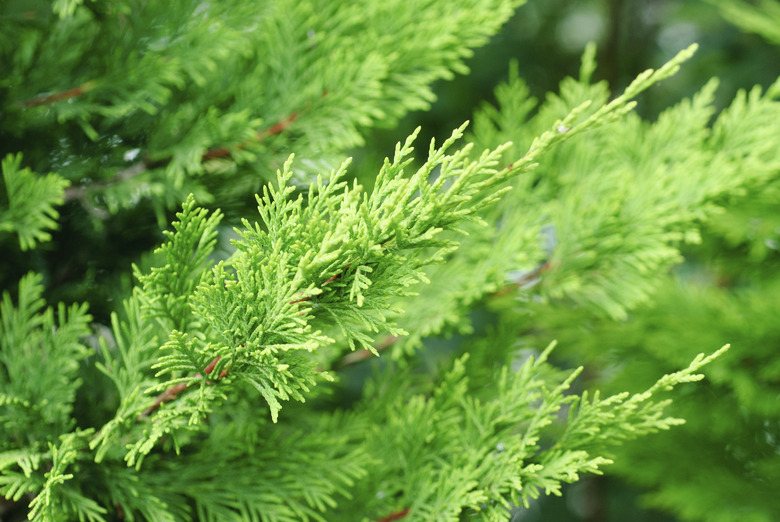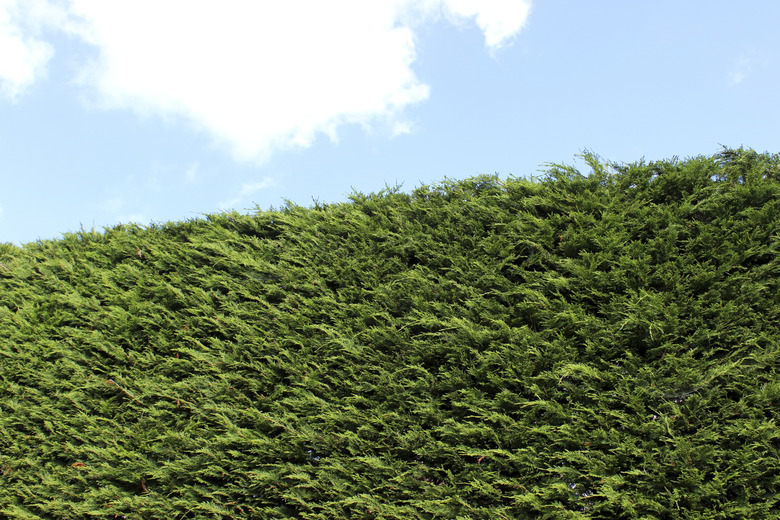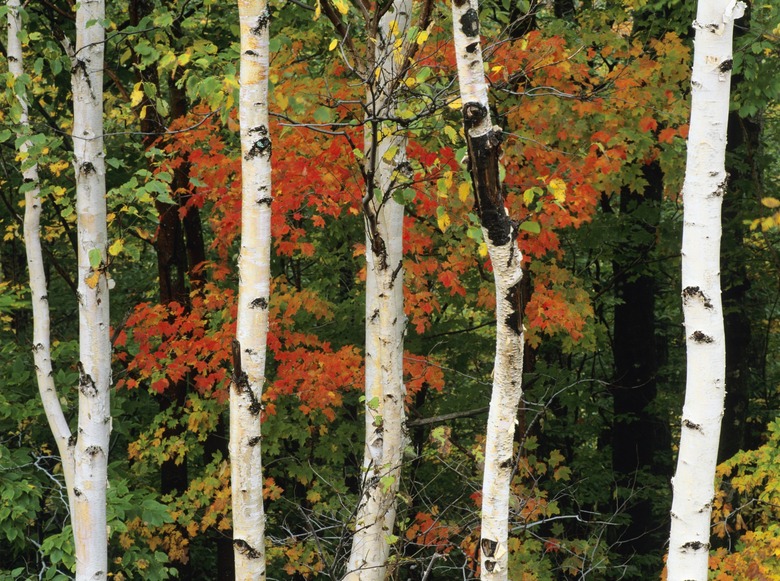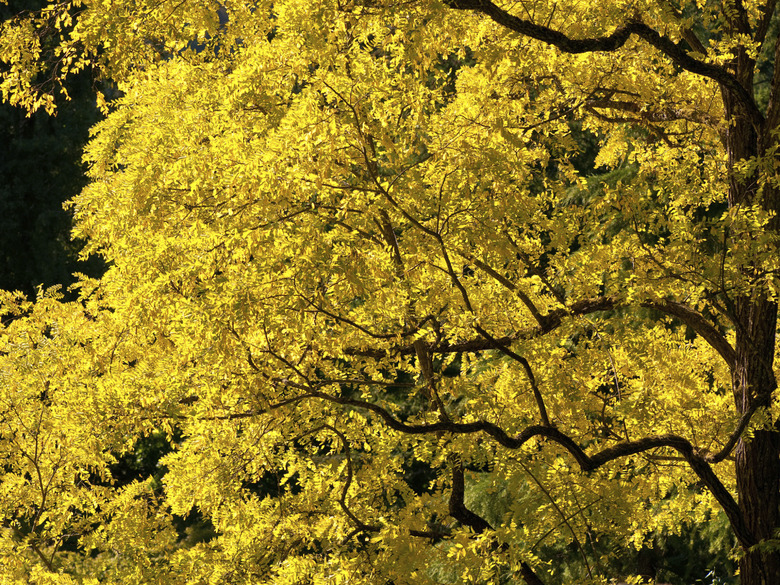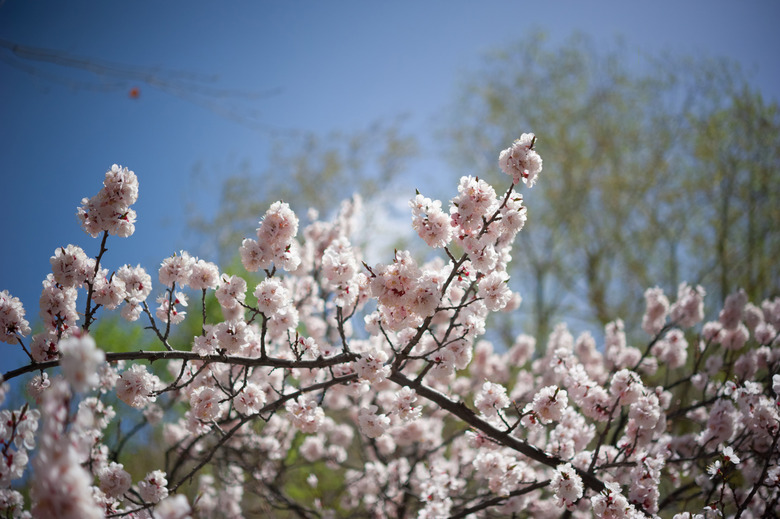The Best Fast Growing Trees For A Natural Fence
If you're looking for a way to define a property boundary without installing a fence, then planting a line of fast-growing trees is an option. Besides being an attraction and low-maintenance once established, a border defined by trees can have other beneficial attributes. It can provide year-round color, flowers, edible fruit or other useful features, depending on the type of tree you choose.
Year-Round Greenery
A row of evergreen trees is a natural fence that stays green all year and can provide shelter for birds during cold weather. The eastern white pine (Pinus strobus) is an example of an evergreen and is hardy in U.S. Department of Agriculture plant hardiness zones 3b through 7, reaching a mature height of 50 to 80 feet and a width of up to 40 feet. It has bluish-green, soft needles, grows about 2 feet each year and is broadly oval with an irregular crown when fully grown. Plant young eastern white pines about 30 to 40 feet apart for the best results. Because eastern white pine may be invasive in some areas, don't plant it near a naturalized area.
The Leyland cypress (x Cuprocyparis leylandii) is another evergreen that grows quickly, adding up to 3 feet in height each year. It has flattened foliage sprays and is hardy in USDA zones 6 through 10, becoming 70 feet tall but only 15 feet wide when mature. Leyland cypress trees make an effective windbreak when spaced 10 to 15 feet apart.
Deciduous Choices
A line of deciduous trees also can be a natural fence, especially with tree types that have winter interest after their leaves fall. The paper birch (Betula papyrifera) is an example. It is a fast-growing and hardy tree, growing up to 2 feet yearly and becoming 50 to 70 feet tall and about 35 feet wide. Its leaves turn gold in fall then drop, revealing the tree's white bark. The tree is hardy in USDA zones 2 through 7. Plant paper birches about 30 to 35 feet apart.
The _lacebark or Chinese elm **(Ulmus parvifolia_), hardy in USDA zones 5b through 10a, can be evergreen in its range's warmest zones. In its other USDA zones, its leaves turn from green to red or yellow then fall to reveal green-to-gray, mottled bark. The Chinese elm grows up to 2 feet each year, reaching about** 50 feet tall and 35 to 50 feet wide*, and it has strong, wind-resistant, slightly weeping branches.
Form a natural fence by placing these trees about 35 feet apart.
A Flowering Fence
By planting a line of ornamental, fast-growing trees that bloom, you can have a natural fence covered in color at their flowering time. The Japanese crape myrtle (Lagerstroemia fauriei) is an example that is hardy in USDA zones 6b through 10a. A multi-trunked tree, it quickly becomes 35 feet tall and 25 feet wide. So allow about 25 feet between multiple specimens to make a natural fence. Japanese crape myrtle's upright, vase-shaped canopy is covered by showy white flowers in summer, and its red and brown bark provides winter interest.
The golden locust (Robinia pseudoacacia "Frisia") is another flowering tree that grows quickly, becoming 30 feet high and wide. Allow about 30 feet between trees when planting them in a row. Golden locust's long clusters of white flowers appear in late spring or early summer and perfume the air with their fragrance, and its foliage is golden yellow. Golden locust is hardy in USDA zones 4 through 9. The tree isn't a suitable choice for a windy spot, however, because its branches can be brittle, and it can be invasive in some areas. So don't plant it near a naturally forested area.
Fruiting Trees
For a dual-purpose approach to a natural fence, plant fruit trees in a line, choosing varieties that suit your region, grow fast and yield a sufficient harvest. Choices include the early golden apricot (Prunus armeniaca), which produces **large fruits in mid- to late summer and grows 15 feet tall and wide.** It is hardy in USDA zones 5 through 8, has pink or white flowers in spring and tends to be evergreen, two additional bonuses. Leave about 5 feet of space between these trees when planting them.
The Kieffer pear (Pyrus communis x Pyrus pyrifolia) is another fruit-bearing tree that grows quickly, eventually becoming **20 feet tall and wide.** It is hardy in USDA zones 4 through 9, flowering in late spring and yielding fruit in fall. Multiple specimens of it form a natural fence when spaced about 20 feet apart.
Both of these trees are self-fertile but bear a heavier yield of fruit when grown near another variety of apricot or pear, respectively, for cross-pollination.
References
- University of Florida IFAS Extension: Pinus Strobus — Eastern White Pine
- Missouri Botanical Garden: x Cuprocyparis Leylandii
- Arbor Day Foundation: Paper Birch, Betula Papyrifera
- Fine Gardening: Golden Locust, Robinia Pseudoacacia "Frisia"
- U.S. Department of Agriculture, Forest Service: Lagerstroemia Fauriei, Japanese Crape Myrtle
- Arbor Day Foundation: Early Golden Apricot, Prunus Armeniaca
- Arbor Day Foundation: Kieffer Pear, Pyrus Communis x Pyrus Pyrifolia
